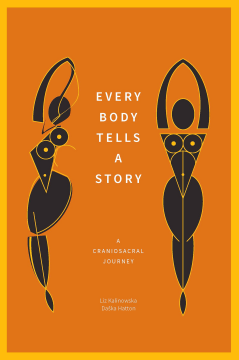
Additional Information
Book Details
Abstract
Liz Kalinowska and Daška Hatton invite you into the therapy room to experience a therapeutic encounter through the lens of Craniosacral Therapy, discussing ways that therapists and clients can work together to optimise the success of treatment.
Describing a unique journey through ten bodywork sessions from the standpoints of a fictional client 'Anna', and her therapist, 'Sarah', the authors take you behind the scenes to witness the client's voyage of discovery, and how the encounter appears to her therapist during the course of treatment. The book shows how the perspectives of both participants develop and widen through their shared experiences and examines the ups and downs of the therapeutic relationship. Boundary, transference and trust issues are explored as Liz and Daška share their own experiences of more than 40 years in practice and examples from myth and legend help to place the work in a wider context.
Liz Kalinowska is a Fellow and former chair of the Craniosacral Therapy Association, and is a Registered Craniosacral Therapist with more than 20 years' experience of working with adults, children and babies. She has also trained in Osteopathy, Dietary Therapy and Counselling, and is an experienced teacher and supervisor.
Daška Hatton initially trained as an Alexander Technique teacher, qualifying in 1998. She is a Registered Craniosacral Therapist and has been a Trustee of the Craniosacral Therapy Association. She teaches at the Alexander Technique School, Queen's Park.
They both live in London, UK.
A fascinating account of ten sessions of Craniosacral Therapy. Written in the form of first person accounts from the perspectives of client, therapist and the authors, it takes the reader on a journey through their inner worlds, and clearly demonstrates the power and subtlety of a form of therapy which connects body and mind so well.
Robin Shohet, Psychotherapist and Author
Liz and Daška have presented a powerful journey through the personal and interpersonal processes that emerge as craniosacral sessions unfold and deepen. They stress that they are writing from a feminine perspective and that is so essential to hear and receive. Craniosacral work is essentially feminine in nature, based on states of presence, relationship and a deepening into a depth of listening and stillness. It is from this depth of presence, relationship and stillness, as the founder of the work, William Garner Sutherland, stressed, a deeper intelligence emerges and session work unfolds uniquely in each moment of time. I really appreciated the personal journeys described in this volume and hope it supports all readers in their own journey in life within the whole spectrum of joy, sorrow and healing processes.
Franklyn Sills, Co-Founder and Co-Director of the Karuna Institute, author, Foundations in Craniosacral Biodynamics
I went (to Liz) for Craniosacral Therapy after suffering from a bad fall that had aggravated lumbar arthritis and after the failure of painful conventional treatments which hadn't provided any long-term relief. At first I was a little sceptical about the treatment but I found it to be relaxing, restoring and healing, and it has improved the quality of my life considerably. Reading this book reminded me of my own very positive experience of this work. No question, should the need arise, I shall return for more treatment.
Chris McVie, Fleetwood Mac
An interesting insight to the work of these healers and the compassion and thought they bring to their clients.
Susie Orbach, psychotherapist and author of Bodies
A description of the evolving relationships between craniosacral psychotherapists and their clients. The lesson is beyond the title being true for any health caretaker and his patients young or old. An easy and pleasant read.
Zvi Laron
Pediatric Endocrinology Reviews, Vol. 15, No. 1, September 2017
Table of Contents
| Section Title | Page | Action | Price |
|---|---|---|---|
| Every Body Tells A Story Every Body Tells A Story - A \nCraniosacral Journey by Liz Kalinowska and Daška Hatton | 5 | ||
| In the Beginning | 13 | ||
| Chapter one - Departure | 25 | ||
| Chapter two - Feeling the Way | 45 | ||
| Chapter three - Where Have I Come From? | 61 | ||
| Chapter four - Resistance | 81 | ||
| Chapter Five - Boundaries | 105 | ||
| Chapter six - Separation | 123 | ||
| Chapter Seven - Meetings | 137 | ||
| Chapter Eight - Despondency | 153 | ||
| Chapter Nine - Acceptance | 169 | ||
| Chapter ten - Closure and Return | 183 | ||
| Blank Page |
